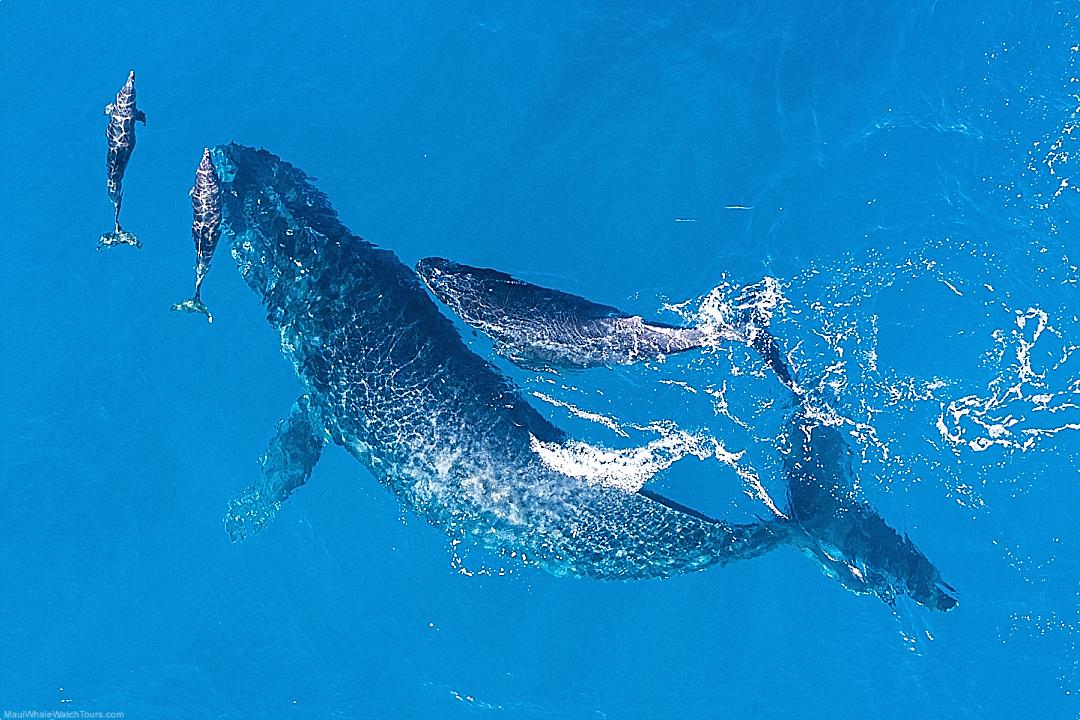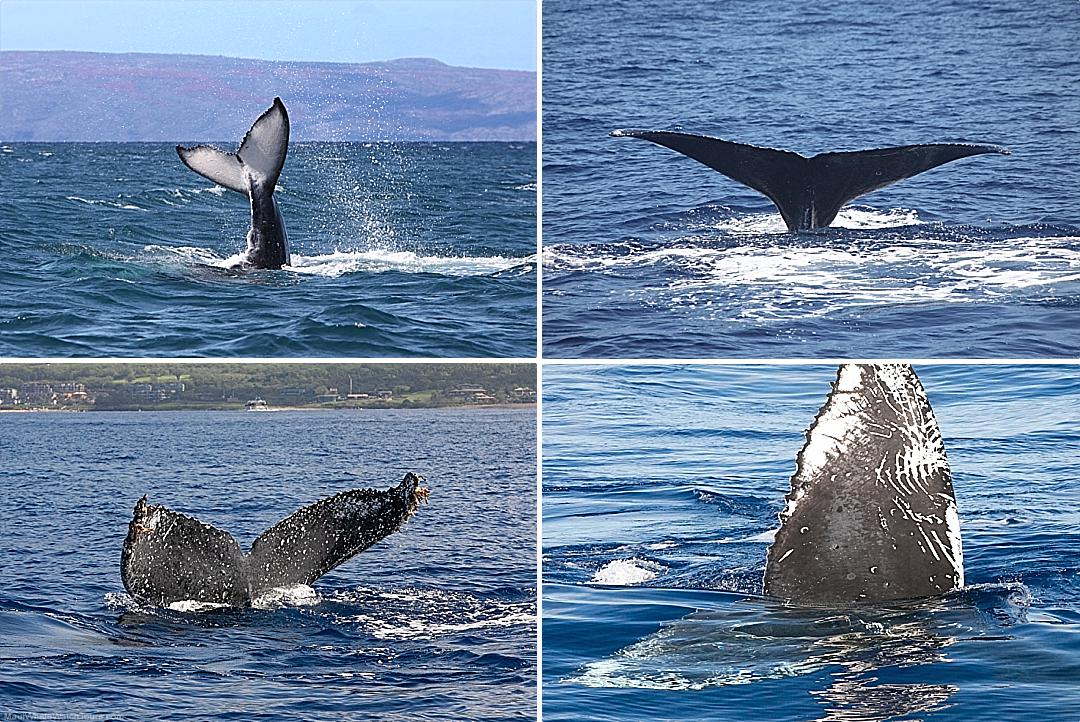All About Maui Whales
Every year, from late November to May, we see an influx of migrating whales in Maui coming to the warm waters surrounding the island. A truly magical time that should not be missed.
All About Maui Whales
These majestic creatures come from all over the world to breed, feed and play in the beautiful ocean off Hawaii’s shores. Every year, our Maui humpback whales offer a unique opportunity to get up close and personal with these enormous animals in their natural environment. Join us as we explore why whales visit Maui each year!


Maui Whale Facts
From November to May, the North Pacific humpback whales utilize the aquatic environment surrounding the Hawaiian Islands as their breeding grounds and preferred location for giving birth to their young ones. During the warmer summer months, these marine creatures venture to the nutrient-rich coastal waters of Alaska to satiate their hunger and nourish themselves. So, technically, on Maui, we can call them OUR whales.
Of all the large whale species, humpbacks are most notable for their extraordinary acrobatic skills. While in Hawaiian waters, it’s believed the primary activities witnessed among these whales are due to male rivalry, mating rituals, and the nurturing and rearing of their calves.

The humpback whale populations in the North Pacific tend not to venture past the equator to interact or mingle with their counterparts in the South Pacific. This behavior can be attributed to the differing breeding and feeding seasons that dictate their migration patterns, with a six-month gap separating the two hemispherical groups. Consequently, these two populations maintain distinct life cycles and rarely have the opportunity to cross paths.
The migratory patterns of male and female humpback whales differ in the North Pacific. Male humpbacks exhibit a wide range of movement throughout the region. In contrast, female humpbacks exhibit fidelity to specific feeding and breeding locations, returning to the same areas on an annual basis. This information contributes to a more comprehensive understanding of the intricate behavioral patterns of these magnificent marine mammals.
Observations of local movement patterns in marine life can be effectively monitored by land-based surveyors employing advanced computerized equipment. In contrast, tracking extensive, long-term movements necessitates the utilization of satellite transmitters in combination with remote underwater listening posts.

When it comes to humpback whales, they attain sexual maturity around the age of 7 or 8 years. They do not appear to engage in reproductive behaviors like mating and giving birth until they are 12 years old or older.
Humpback whales are equipped with tail flukes that serve as a means of propulsion, enabling them to navigate through the water via an undulating motion. These flukes can reach an impressive width of up to 15 feet, providing substantial power to propel the massive creatures.

As the number of humpback whales in Hawaiian waters continues to rise, it may become imperative to implement additional protective measures, such as speed restrictions for larger vessels like grandfathered ships and ferries. Additionally, employing trained observers aboard these vessels can further minimize the chances of collisions, thereby ensuring the safety of these majestic marine mammals.
The blubber of a humpback whale, which comprises nearly 30 percent of its total body mass, serves as both an energy reservoir and an essential insulator, maintaining its core body temperature. The layer of blubber can reach a thickness of up to seven inches, highlighting its crucial role in the whale’s survival and overall well-being.

Typically, young calves come up to inhale air every three to four minutes, whereas their mothers remain underwater for a minimum of double the duration.
An infant whale calf is capable of consuming an astonishing 100 gallons of milk daily. If you go Maui whale watching, you’ll often see calves breaching (probably after a good meal.)
Mature humpback whales have a diet that primarily consists of minute shrimp-like creatures known as krill, as well as a variety of small, gregarious fish species, including herring, capelin, sand lance, and mackerel, providing a rich and highly nutritious sustenance.

Hydrophones, also known as underwater acoustic sensing devices, possess the remarkable ability to capture the melodious tunes produced by male humpback whales from several miles away. Research conducted by marine biologists has established that these male whales tend to be more vocal during nighttime compared to daytime hours.
The mighty humpback whales are hosts to numerous parasitic organisms. On the one hand, they carry ectoparasites, such as barnacles, that cling to their skin’s surface. On the other hand, they are infested by endoparasites like flatworms (including tapeworms) and roundworms (such as hookworms), which tunnel beneath their epidermal layer, invading various internal organs and body cavities. Interestingly, humpback whales serve as the exclusive host to a unique parasite known as Haematophagus Megapterae. This specialized organism embeds itself within the baleen plates of humpback whales, nourishing itself by consuming the host’s blood cells.

When Maui whales breach and forcefully tail slap, they tend to shed tiny fragments of their skin into the surrounding waters. By conducting a genetic examination of these skin samples, researchers are able to gather crucial information about the mammal, including its gender, paternity, the number of biotoxins it has been exposed to, as well as understanding the relationships between various whale populations.

The proportion of male-to-female calves born in the whale community is generally balanced, with an approximate 1:1 ratio. Lady humpback whales usually conceive their offspring in our warm waters and return to the same region the following year for the birthing process. While it is common for these females to have a one-year gap between pregnancies, there are instances where they can become pregnant immediately after giving birth, showcasing their reproductive abilities.
Humpback whales exhibit remarkable acrobatic displays, such as breaching, a term used to describe their impressive leaps out of the water. These energetic demonstrations convey information about the whale’s location, physical condition, and emotional state. Researchers also suggest that breaching offers them a chance to visually explore their surroundings above water, and sometimes, the whales might engage in this activity simply for enjoyment. If you get to see humpback whales breach, you’re in for a treat! You’ll likely see it happen if you book one of our Maui whale watching tours in season.

To enhance their ability to swim with ease, whales lack external ear flaps and hind limbs. Moreover, humpback whales have genitalia and mammary glands that measure around seven feet in length and two feet in width. These are fully enclosed within their body cavity, further streamlining their bodies for efficient movement in their aquatic environment. In short, they’re growers, not showers.
Each humpback whale possesses distinct combinations of markings and coloration on the undersurface of their tail flukes. Scientists utilize photography to distinguish and recognize individual animals based on these unique patterns. By doing so, they can then establish long-term case histories for the documented whales.

More recently, there has been a noticeable rise in orca whale sightings near the Hawaiian Islands. This could be attributed to the growing population of migrating humpback whales that are recuperating from the damaging effects of commercial whaling, thereby attracting the orcas to the region. During the season, you’ll see more whales in Maui than ever before!
The whale-watching industry is flourishing, bringing in an annual revenue of $20 million in Hawaii alone and over $1 billion on a global scale. As a popular tourist attraction among the Hawaiian Islands, approximately 450,000 visitors take a whale-watching tour each year. This not only highlights the significance of protecting these majestic creatures but also emphasizes the importance of maintaining a healthy and thriving ocean ecosystem.
Whale watching in Maui is an amazing experience that will stay with you for a lifetime. Seeing these beautiful and majestic animals living in their natural habitat and having the chance to observe them in their element is truly unforgettable. Whether you’re visiting Maui for the first time or have come here every year, don’t miss this incredible chance to witness whales in the wild around Hawaii’s coasts. Just make sure you come during humpback whale season (mid-December through April!)


Redline Rafting
Enjoy whale watching with Redline Rafting, which provides an exciting, up close and personal experience on a one-of-a-kind boat that will get you close to the water and whales!
Pride of Maui
The Pride of Maui is a stable, spacious catamaran with open decks for incredible views. Naturalists on board share insights about humpback behavior as you watch for breaches, tail slaps, and mothers with calves. With plenty of room, shade, and fresh meals, it’s a comfortable and family-friendly way to whale watch.



